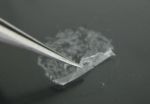(Press-News.org) SAN FRANCISCO, Aug. 10, 2014 — Wrapping wound dressings around fingers and toes can be tricky, but for burn victims, guarding them against infection is critical. Today, scientists are reporting the development of novel, ultrathin coatings called nanosheets that can cling to the body's most difficult-to-protect contours and keep bacteria at bay.
The researchers are speaking about their materials, which they've tested on mice, at the 248th National Meeting & Exposition of the American Chemical Society (ACS), the world's largest scientific society.
The meeting features nearly 12,000 presentations on a wide range of science topics and is being held here through Thursday.
Yosuke Okamura, Ph.D., explains that existing wound dressings work well when it comes to treating burns on relatively flat and broad areas. But the human body has curves, wrinkles and ridges that present problems for these dressings. So Okamura's team developed a novel biomaterial out of tiny pieces of nanosheets that are super-flexible and sticky.
"The nanosheets can adhere not only to flat surfaces, but also to uneven and irregular surfaces without adding any adhesives," he says.
That would make a big difference in the way burn victims are treated. According to the Centers for Disease Control and Prevention, someone is injured by fire every 30 minutes. Burn wounds are vulnerable to infection, and keeping them sealed off from bacteria is essential for a successful recovery.
Okamura's team at Tokai University makes the nanosheets out of a biodegradable polyester called poly(L-lactic acid), or PLLA. They put the material into a test tube with water and spin it, which breaks up the sheets into even smaller pieces. When they pour the liquid onto a flat surface, the tiny fragments overlap in a patchwork and dry as a single nanosheet.
They tested out the nanosheets' ability to coat small and irregular shapes by dipping different things into the mixture, including a metal needle and a mouse's fingers. The nanosheet patchwork effectively covered even the smallest bumps and wrinkles on the mouse's digits, and after the material dried, it clung in place.
When the researchers tested the nanosheets on burns, the dressing effectively kept out the common bacteria, Pseudomonas aeruginosa. This species of pathogen is often a culprit in skin infections and is notorious for causing hospital-acquired infections that can be deadly. Multi-drug resistant strains are also a serious concern.
The dressing protected wounds from infection for three continuous days. With an additional coating, the nanosheets kept bacteria out for a total of six days. That means the material, if eventually approved for human patients, could cut down the number of times dressings have to be changed. With an eye toward human clinical trials, the researchers are currently planning large-scale animal tests and safety tests.
In addition to PLLA nanosheets, Okamura's group has recently started developing a novel set of similar, super-flexible, patchwork coatings composed of polymers with a phosphorylcholine group. They have shown that these materials are compatible with blood and could act as coatings for medical devices, such as catheters.
INFORMATION:
Okamura acknowledges funding from the Japan Society for the Promotion of Science.
The American Chemical Society is a nonprofit organization chartered by the U.S. Congress. With more than 161,000 members, ACS is the world's largest scientific society and a global leader in providing access to chemistry-related research through its multiple databases, peer-reviewed journals and scientific conferences. Its main offices are in Washington, D.C., and Columbus, Ohio.
To automatically receive news releases from the American Chemical Society, contact newsroom@acs.org.
Note to journalists: Please report that this research is being presented at a meeting of the American Chemical Society.
Follow us: Twitter | Facebook
Title
Development of fragmented nanosheets and patchwork coating as aqueous surface modifiers for biomedical applications
Abstract
Free-standing ultra-thin films (often called nanosheets) composed of biocompatible polymers (size >cm, thickness END
Like cling wrap, new biomaterial can coat tricky burn wounds and block out infection
2014-08-10
ELSE PRESS RELEASES FROM THIS DATE:
Women who 'lean in' often soon leave engineering careers, study finds
2014-08-09
WASHINGTON –- Nearly 40 percent of women who earn engineering degrees quit the profession or never enter the field, and for those who leave, poor workplace climates and mistreatment by managers and co-workers are common reasons, according to research presented at the American Psychological Association's 122nd Annual Convention.
While women accounted for more than 20 percent of engineering school graduates over the past two decades, only 11 percent of practicing engineers are women, and only 9 percent of electronic and environmental engineers are, said Nadya Fouad, PhD, ...
Happier consumers can lead to healthier environment, research reveals
2014-08-09
WASHINGTON -- The pursuit of true happiness can lead people to lifestyles that will not only be satisfying but will be better for the environment, according to an overview of psychological research presented at the American Psychological Association's 122nd Annual Convention.
"For decades, consumerism has been on a collision course with the environment, with consumer appetites draining the planet of natural resources and accelerating global warming. One view is that we need to change consumption in order to save the planet," said Miriam Tatzel, PhD, of Empire State College. ...
Trauma before enlistment linked to high suicide rates among military personnel, veterans
2014-08-09
WASHINGTON -- High rates of suicide among military service members and veterans may be related to traumatic experiences they had before enlisting, making them more vulnerable to suicidal behavior when coping with combat and multiple deployments, according to the findings of several recent studies presented at the American Psychological Association's 122nd Annual Convention.
Experiencing child abuse, being sexually victimized by someone not in the service and exhibiting suicidal behavior before enlisting are significant risk factors for service members and veterans who ...
Regular marijuana use bad for teens' brains
2014-08-09
WASHINGTON –- Frequent marijuana use can have a significant negative effect on the brains of teenagers and young adults, including cognitive decline, poor attention and memory, and decreased IQ, according to psychologists discussing public health implications of marijuana legalization at the American Psychological Association's 122nd Annual Convention.
"It needs to be emphasized that regular cannabis use, which we consider once a week, is not safe and may result in addiction and neurocognitive damage, especially in youth," said Krista Lisdahl, PhD, director of the brain ...
Individual genotype influences effectiveness of HIV vaccine
2014-08-09
Almost 40 million people worldwide live with HIV/AIDS. Despite great effort, HIV-1 vaccine development has been challenging. A recent HIV vaccine trial, known as RV144, revealed that a combination of 2 vaccines protected some individuals from HIV infection. Individuals in the trial that made antibodies that bound to a specific region of the HIV envelope protein had a decreased risk of HIV infection. A new study in the Journal of Clinical Investigation reveals that an individual's genotype correlates with their ability to develop immunity to HIV in response to vaccination. ...
Improving lymphatic function protects mice from experimental colitis
2014-08-09
Chronic inflammatory bowel disease can be painful and debilitating. Both genetics and environment are thought to promote disease, but it is not fully understood how chronic IBD develops. Emerging evidence indicates that IBD is associated with an increase in lymphatic vasculature, which transports lymph throughput the body. It is not clear if these lymphatic vessels promote or improve IBD. A new study in the Journal of Clinical Investigation indicates that improving lymphatic function relieves experimental IBD in mice. Silvio Danese and colleagues at Humanitas Clinical and ...
Lead linked to obesity in mice exposed by mothers
2014-08-08
ANN ARBOR—When we think of ill effects from lead exposure various neurologic problems usually come to mind. Now researchers at the University of Michigan say another health impact can be added to the list: obesity.
Even at low levels, lead is associated with obesity in mice whose mothers were exposed to the chemical, researchers at the U-M School of Public Health found. Specifically male mice exposed to lead had an 8-10 percent increase in weight.
"The data support the obesogen hypothesis that toxicant exposures in the womb contribute to the higher rate of obesity," ...
Disney Researchers develop method to capture stylized hair for 3-D-printed figurines
2014-08-08
Perhaps no aspect of 3D printing has captured the popular imagination more than personalized figurines with the facial features of real people. Now, researchers at Disney Research Zurich and the University of Zaragoza have developed a method that can incorporate an individual's hairstyle as well.
The researchers will present their new method at ACM SIGGRAPH 2014, the International Conference on Computer Graphics and Interactive Techniques in Vancouver, Aug. 10-14.
Miniature statues with a person's likeness are nowadays produced by scanning the individual's face with ...
Expecting to teach enhances learning, recall
2014-08-08
"When compared to learners expecting a test, learners expecting to teach recalled more material correctly, they organized their recall more effectively and they had better memory for especially important information," said lead author John Nestojko, PhD, a postdoctoral researcher in psychology in Arts & Sciences at WUSTL.
The study, published recently in the journal Memory & Cognition, is based on a series of reading-and-recall experiments in which one group of students is told they will be tested on a selection of written material, and another group is led to believe ...
Water's reaction with metal oxides opens doors for researchers
2014-08-08
MADISON, Wis. — A multi-institutional team has resolved a long-unanswered question about how two of the world's most common substances interact.
In a paper published recently in the journal Nature Communications, Manos Mavrikakis, professor of chemical and biological engineering at the University of Wisconsin-Madison, and his collaborators report fundamental discoveries about how water reacts with metal oxides. The paper opens doors for greater understanding and control of chemical reactions in fields ranging from catalysis to geochemistry and atmospheric chemistry.
"These ...

